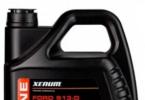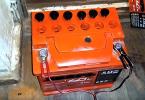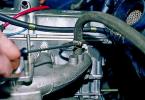Most motorists evaluate cars according to external data, technical equipment and equipment features, not paying due attention to the parameters of the fuel tank. However, this detail can affect the performance of the vehicle. In particular, the parameters of the Renault Duster fuel tank determine the power reserve and the ability to overcome off-road terrain.
General characteristics of the gas tank
A cross-linked polyethylene gas tank is installed on Renault Duster. There are several reasons for the use of this material:
- Cross-linked polyethylene has a high density, due to which the gas tank can withstand mechanical stress from the outside. This material is tough and elastic at the same time.
- Plastic is lighter than aluminum (used mainly for LPG tanks). Therefore, after installation, such a gas tank practically does not affect the total weight of the car.
- Plastic, unlike aluminum and steel, is not susceptible to corrosion and oxidation.
Officially, the size of the gas tank on Renault Duster allows you to fill up to 50 liters of fuel. However, in reality, this parameter differs from the declared one. The discrepancies are explained by the fact that the manufacturer, in order to avoid negative reviews, underestimates the indicator of the Renault Duster tank volume.
Gas tank volume and fuel consumption
According to the reviews of the owners of Duster, the volume of the gas tank of the French crossover is 60 liters. However, in reality, the container is rarely filled with so much fuel. This is due to the fact that with intensive fuel filling, an air lock forms inside, which interferes with the further movement of the liquid. To "increase" the volume of the Renault Duster gas tank, it is recommended to reduce the rate of fuel intake.
The fuel consumption indicator is determined by the characteristics of vehicle operation. In addition, this indicator is influenced by the type of equipment in which the crossover is performed.
According to the passport data, Renault Duster consumes every 100 km of track:
- 6.3 liters in the version with manual transmission, 1.6-liter engine and front-wheel drive;
- 6.8 liters - manual transmission, 1.6 liters and four-wheel drive;
- 6.5 liters - manual transmission, 2 liters and four-wheel drive;
- 7.2 liters - automatic transmission, 2 liters and front-wheel drive;
- 5 liters - manual transmission, 1.5 liter diesel engine and four-wheel drive.
According to the results of testing carried out by the manufacturer, Renault Duster in the specified configurations at a speed of 110 km / h and with a full gas tank is able to drive, respectively:
- 794 km;
- 735 km;
- 769 km;
- 694 km;
- 1000 km.
Based on the above information, it turns out that the most economical version is the diesel version. However, in real conditions, the performance of the car changes (usually downward).
Fuel tank location
When developing the Duster, Renault used the solutions implemented in most modern cars. In particular, this applies to the location of the gas tank. The manufacturer installed the fuel tank under the right-hand rear seat, securing it directly in front of the axle.
This arrangement is due to the results of numerous crash tests. Research has shown that the fuel tank will not deform in the event of a rear impact.
If the vehicle is operated in difficult conditions, it is recommended to install additional protection on the tank.
Device
The gas tank for Renault Duster consists of the following elements:
- lid;
- neck;
- pipeline;
- intake;
- fuel pump.
The cover closes the drain hole, preventing the filling of the tank volume on the Renault Duster with air, dust or dirt. Such inclusions reduce the quality of the fuel. A neck is located between the hatch and the pipeline through which fuel enters the gas tank. This element is located above the rear wing.
The pipeline is an elastic tube, the design of which allows filling the entire volume of the gas tank in a minute. The fence has an important function. This component supplies fuel to the fuel line. The rest of the liquid goes back to the tank. Additionally, the intake removes large fractions from the fuel, preventing clogging of the fuel system. On diesel models, this component also includes heating.
A special pump is responsible for supplying fuel at a given pressure. In addition, this component controls the fuel level and other indicators.
In addition to the above details, a reverse-acting valve is provided in the design of the gas tank. This part maintains the pressure inside the container at a certain level. A decrease in the set parameters leads to deformation or rupture of the walls of the gas tank.
The reverse acting valve functions in automatic mode. As soon as the pressure in the fuel tank drops to critically low values, the specified part opens, allowing air to enter the tank.
Renault Duster uses another valve. The latter prevents fuel from escaping when the car rolls over.
How to drain gasoline from Renault Duster
Duster, unlike Russian cars, does not have a drain plug on the bottom of the gas tank. Therefore, draining fuel can cause certain problems.
How to drain gasoline from Renault Duster? To remove liquid from the fuel tank, insert a tube with a diameter of no more than 10 mm into the neck of the latter. Pull the liquid towards you through the free end, avoiding gasoline getting into your mouth.
In some Renault Duster trim levels, a fuel filter is located under the rear right wheel. To remove the gasoline, the inlet pipe must be removed and placed in a suitable container. After that, you need to turn on the ignition to position 2, in which the fuel pump starts.
There is another way to remove fuel from the tank. To do this, you need to remove the fuel pump, which can be reached through a special hole in the luggage compartment.
These methods are only suitable for those cases when it becomes necessary to drain gasoline. If a diesel engine was poured into the tank, then you need to completely clean the fuel system, including filters and the pump.
Gas tank care
Most car owners do not think about caring for their fuel tank. In this case, over time, various impurities settle on the walls of the container, which can completely cover the cleaning mesh. As a result, the operation of the gas pump will be disrupted, and the engine will receive insufficient fuel.
To avoid such problems, it is recommended that a special mixture (additive) be poured into the Duster's fuel tank every 10 thousand kilometers. The latter will remove impurities from the system, thereby preventing clogging of the filters. In extreme cases, when the driver has not used the additive for 40-50 thousand kilometers, it is necessary to seek specialized help. In this situation, mechanical cleaning of the fuel system will be required. Otherwise, you will have to make rather expensive repairs.
Conclusion
Renault Duster is equipped with a sufficient fuel tank. Subject to the operating conditions recommended by the manufacturer, the car, regardless of the configuration type, is capable of driving about 500 km without additional refueling with a full tank. The gas tank of the French model is made of durable plastic that can withstand mechanical stress and does not corrode.
During the operation of Renault Duster, it is necessary to pay attention to the maintenance of not only the main units and connections, but also the gas tank. The fuel storage and supply system requires regular cleaning of impurities that have a negative impact on the operation of the entire vehicle. Due to blockages in the fuel tank, the engine stops working or fails.
In the event that a light on the dashboard lights up, indicating an imminent fuel consumption, it is necessary to fill in a little gasoline or diesel. Otherwise, problems with the gas pump will soon arise.
Video
When choosing a car, not everyone pays attention to such an important element of the fuel system as the fuel tank. But it is an important constructive component. It is in this container that the fuel is stored intact and safe, leaks are prevented and emissions during evaporation are limited. And is of decisive importance. The required frequency of visits to gas stations depends on this. Often, autonomous mileage is provided for a distance of four to six hundred kilometers. In the case of the Duster, the volume of its fuel tank is 50 liters.
As a rule, on all passenger cars, the fuel tank is located in front of the rear axle under the rear seat. If a rear-end collision occurs, this area is not deformed. The device is attached to the car body by means of tape clamps. Installation of additional mechanical protection against possible damage is allowed. Nowadays, it is quite common to find the use of heat-insulating gaskets, which help prevent heating from the elements of the exhaust system.
Metal tanks are welded from stamped sheets. Steel is used to store gas, and aluminum is used for diesel or gasoline. It is no secret that each new model strives to use new solutions, and the Duster fuel tank is no exception. The company's engineers tried to optimize the free space as much as possible. There are differences depending on engine type, bodywork, fuel system design and injection system.
If we talk about fuel tanks in general, then, in addition to a metal structure, they can also have a plastic one. This material is a high strength polyethylene, which is the most commonly used today. It can create maximum ease of use of the installation space, because you can give any shape during molding in order to get the maximum volume. Plastic is not subject to corrosive processes. To avoid even the slightest leak, plastic fuel tanks are made multi-layered. Also, their surface can be coated with fluorine, again to prevent leaks.
Returning to the volume of the Renault Duster fuel tank, it should be noted that it is enough for everyday use, and even despite its "off-road" nature. After all, fuel consumption can be considered small. In particular, as tests carried out by various journalists show, the maximum fuel consumption can reach 10-11 liters per hundred kilometers. This is under extremely unfavorable conditions for using the "anther". If we talk about standard conditions of use, a mixed cycle, then the consumption is within 7 liters per hundred kilometers. Therefore, a full fuel tank will be enough to cover about seven hundred kilometers without refueling.
Duster is a completely unique offer in its class - this light car has a pretty decent maneuverability and maneuverability along with low fuel consumption. What else do you need in order to constantly travel to work and nature with your family? All four-wheel drive models are equipped with a 6-speed gearbox for flexible handling in a wide variety of driving situations.
Gathered in a big company for fishing? Duster can easily accommodate 5 people, and the luggage compartment volume is enough to take everything you need with you without any problems. You can transport rather large things by folding the rear seat and, as a result, you have about 1636 liters of free space at your disposal.
Renault Duster 1.6 4x4 - four-wheel drive
Four-wheel drive has always been appreciated in Russia, because it significantly increases the capabilities of the car, giving its owner more freedom of movement on difficult road sections at any time of the year.
A special role is played by the design of the car, which was developed by professionals in their field - as a result, Duster can boast of a modern and aggressive appearance, so it easily stands out among the large stream of cars. A rather impressive ground clearance deserves a separate word, as well as special body protection - enjoy a comfortable and confident ride wherever you are.
Fuel consumption
Any car owner is always interested in the cost of its maintenance, which includes maintenance, gasoline and oil consumption and other things. According to the reviews received by many fans, the average fuel consumption of Renault Duster 1.6 4x4 is as follows:
- Track - 7.5 - 8 L
- City - 11 - 12 L
- Mixed cycle - 8.5 - 9 l
Of course, we took into account the fact that each driver has his own driving style, so the maximum and minimum values were not taken into account in all calculations. Thus, we get the figures that are closest to real data.
Price of this version
In this version of the engine and drive, there are no models with an automatic transmission and diesel analogues. However, even in this case, it is quite popular and even has certain advantages, especially off-road.
- Authentique - 519,000 rubles
- Expression - 574,000 rubles
- Privilege - 627,000 rubles
Keep in mind that this cost should be added to the delivery of the car to your city, insurance policy and the cost of the loan procedure, if any. In any case, this is not only one of the most inexpensive crossovers, but also economical.
New video test drive
Specifications Renault Duster 1.6 4x4
| Authentique 4x4 1.6 | Expression 4x4 1.6 | |
| Engine | ||
| Engine | 1.6 16v | 1.6 16v |
| Toxicity rate | Euro - 4 | Euro - 4 |
| Working volume | 1598 | 1598 |
| Cylinders, pcs | 4 | 4 |
| Valves, pcs | 16 | 16 |
| Max. power, kW (hp) | 75 (102) | 75 (102) |
| Max. torque (N.m) | 145 | 145 |
| Fuel | petrol | petrol |
| Body | ||
| Type of | SUV | SUV |
| Number of doors | 5 | 5 |
| Fuel tank | ||
| Capacity, liter | 50 | 50 |
| Transmission | ||
| Type of | Mechanical | Mechanical |
| Number of gears | 5 | 5 |
| Wheels and tires | ||
| Dimensions (edit) | 215/65 R 16 | 215/65 R 16 |
| Dynamic indicators | ||
| Max. speed | 158 | 158 |
| Acceleration to 100 km / h, sec | 13.5 | 13.5 |
| Trunk capacity | ||
| Minimum | 408 | 408 |
| Maximum | 1570 | 1570 |
| Dimensions (edit) | ||
| Length | 4315 | 4315 |
| Width | 1822/2000 | 1822/2000 |
| Height | 1625/1695 | 1625/1695 |
| Wheelbase | 2673 | 2673 |
| Clearance | 210 | 210 |
Renault Duster 1.6 4x2 - front-wheel drive
A practical solution for those who are accustomed to the classic front-wheel drive, but at the same time want to enjoy all the amenities of a modern crossover. With such a partner, you can not only travel to work, but also actively travel outside the city along unknown routes, where there may be no normal roads at all.
Fuel consumption
The fuel consumption of Renault Duster 1.6 4x2 is the most interesting for potential buyers. this is the most affordable option of all available, and therefore the most economical.
- Track - 7 - 7.5 L
- City - 10 - 11 L
- Mixed cycle - 8 - 8.5 l
According to the reviews of the owners, approximately the same selection of values was obtained, however, cases were identified when the consumption was significantly higher.
Price for each configuration
The price of Renault Duster 1.6 4x2 is one of the lowest in this segment, and if you are looking for a car with the character of an SUV and good handling in the city, then this is an ideal choice that is available to everyone. So, the current price today looks like this:
- Authentique - 469,000 rubles
- Expression - 524,000 rubles
Specifications Renault Duster 1.6 4x2
| Authentique 4x2 1.6 | Expression 4x2 1.6 MKP5 | |
| Engine | ||
| Engine | 1.6 16v | 1.6 16v |
| Toxicity rate | Euro - 4 | Euro - 4 |
| Working volume | 1598 | 1598 |
| Cylinders, pcs | 4 | 4 |
| Valves, pcs | 16 | 16 |
| Max. power, kW (hp) | 75 (102) | 75 (102) |
| Max. torque (N.m) | 145 | 145 |
| Fuel | petrol | petrol |
| Body | ||
| Type of | SUV | SUV |
| Number of doors | 5 | 5 |
| Fuel tank | ||
| Capacity, liter | 50 | 50 |
| Transmission | ||
| Type of | Mechanical | Mechanical |
| Number of gears | 5 | 5 |
| Wheels and tires | ||
| Dimensions (edit) | 215/65 R 16 | 215/65 R 16 |
| Dynamic indicators | ||
| Max. speed | 163 | 163 |
| Acceleration to 100 km / h, sec | 11.8 | 11.8 |
| Trunk capacity | ||
| Minimum | 475 | 475 |
| Maximum | 1636 | 1636 |
| Dimensions (edit) | ||
| Length | 4315 | 4315 |
| Width | 1822/2000 | 1822/2000 |
| Height | 1625/1695 | 1625/1695 |
| Wheelbase | 2673 | 2673 |
| Clearance | 205 | 205 |
Test drive for evaluation
Another video of the test drive Renault Duster 1.6 4x2, which will be of interest to all potential buyers.
The most popular questions about Duster - video
If you are very interested in this car, we advise you to look at this material, in which the owners of Duster answer the questions of those who are just planning to buy it. As a result, you will be able to finally form an initial opinion about it, and in the future you can secure it with a free test drive at the nearest Renault dealer in your city.
Changing oil, coolant and lubrication of units and assemblies is a standard procedure for any car. This also applies to the Renault Duster. . At the same time, it is important to choose the right material that will have a high-quality composition. There are two ways to perform this procedure:
- Contact a specialist;
- On one's own.
Such a replacement is an uncomplicated but responsible process. Its implementation requires care and accuracy. Mistakes made will negatively affect the operation of the vehicle and cause it to break down at the most inopportune moment. When choosing a fluid, you must take into account different points. The main ones include the mileage of the car, the deterioration of spare parts, the life of the oil after the previous change, and so on. In addition, it is important to correctly calculate the required amount.
As practice shows, saving in this matter is not always appropriate. It is better to entrust a complete change of engine oil to specialists. Lubrication in this case will not be enough. It is also worth contacting him if you see obvious breakdowns, leaks and other phenomena unusual for a car. Otherwise, the situation will only get worse. Fixing it will take time, effort and money to purchase new parts.
If you decide to replace the fluid yourself, then the information below will certainly come in handy. We offer the name of the liquid, the place of application and the volume for each system.

Refueling tanks and liquids Renault Duster
| Filling / lubrication point | Refueling volume | Oil / liquid name |
| Lubrication system: K4M engine F4R engine |
Motor oils of SAE viscosity grade 0W-20, 0W-30, 5W-30 and 5W-40 | |
| Cooling system | 6.0 l | GLACEOL RX (type D), antifreeze concentrate solution in distilled water, amine-free |
| Brake system | 0.7 l | DOT-4 |
| Manual transmission, complete with final drive | 2.8 l | TRANSELF TRJ 75W-80, API GL-4, SAE 75W-85W or 75W-90 |
| Transfer case | 0.9 l | Hypoid gear oil APIGL5SAE 75W-90 (e.g. SHELL S PI RAX X or analogs) |
| Rear axle reducer | 0.9 l | Hypoid gear oil API GL5 SAE 75W-90 (e.g. SHELL SPIRAX X or similar) |
| Automatic transmission complete with final drive: full | 6L | ELF RENAULTMATIC D3 or SYN (DEXRON-III) |
| when replacing | 3.5 l | |
| Constant velocity joints for wheel drives | As needed | SHRUS-4, SHRUS-4M, imported lithium-based greases with 5% molybdenum |
| Power steering fluid | 1.1L | ELF RENAULTMATIC D2 or MOBIL ATF |
| Fuel tank | 60L | Unleaded gasoline with an octane rating of at least 95 |
| Windshield washer reservoir | 3.75 l | In summer - a concentrate of a special fluid for the washer reservoir, diluted with clean water, in winter - an anti-freeze fluid |
| Air conditioning system | 550 g | Refrigerant HFC-134a |
| 150 g | PLANETELF PAG 488 | |
| Air conditioning system | 550 g | Refrigerant HFC-134a |
| Air Conditioning Compressor Oil | 150 g | PLANETELF PAG 488 |
The volume of oils and fluids of fuel and lubricants Renault Duster was last modified: October 10th, 2018 by Administrator



